Sustainable Green Pavement Using Bio-Based Polyurethane Binder in Tunnel
Abstract
:1. Introduction
2. Methods
2.1. Materials and Preparation of the PTO Specimens
2.2. Acoustic Performance
2.3. Reflection Test
2.4. Flammability Evaluation Method
3. Results and Discussion
3.1. Results of the Acoustic Test
3.2. Results of Heat Reflection
3.3. Results of Combustion Tests
3.3.1. Ignition Time (TTI)
3.3.2. Heat Release Rate (HRR)
3.3.3. Total Heat Release (THR)
3.3.4. Specific Extinction Area (SEA) and Total Smoke Release (TSR)
3.3.5. Fire Proceeding Index (FPI)
4. Summary and Conclusions
- Based on the evaluation by the acoustic tube test, both PU and OGFC show superior acoustic properties in comparison with conventional SMA and concrete pavement materials. However, comparing to OGFC, PU has a wider range of noise absorption. Especially for high frequency noise, which more likely exists in the tunnel, PU exhibits a maximum noise absorption coefficient, while other materials have almost no noise absorption within this range. Concluding, PU is more efficient in noise reduction of tunnel pavement.
- The light reflection rate varied significantly among different pavement surfaces. Based on the heat reflection tests, the OGFC and SMA which use bitumen as a binder material, exhibit the lowest heat reflectance values. The concrete presented the highest reflection rate and followed by PU in wavelength it ranged from 800 to 2000 nm. On the other hand, an increase of the radiation time results in a significant increase in the surface temperature of the PU and asphalt material. However, compared to the asphalt material, the increase of temperature on the PU surface is almost 30% less. Therefore, this PU pavement surface can potentially lessen the urban heat island effect. It is meaningful when the PU is applied in the entrance and exit sections of the tunnel, where it is not completely sealed under the tunnel section.
- By comparing the results of the combustion tests, it can be seen that PU has a better flame retardancy than asphalt (OGFC and SMA). Particularly, the TTI of PU is larger than that of OGFC and SMA, indicating that PU is more difficult to ignite than asphalt. Asphalt (OGFC and SMA), with the higher pkHRR than PU, can result in faster combustion and a greater risk of fire. SMA has the largest THR, indicating that the largest amount of heat is released. The THR of OGFC is close to that of PU, but the ignition time of OGFC is small, and thus the heat release is more concentrated and intense. SMA has the largest average smoke emission and total smoke emission, followed by OGFC, PU and cement. FPI of asphalt is smaller than that of PU.
Author Contributions
Funding
Conflicts of Interest
References
- Zhang, J.; Wang, M.; Wang, D.; Li, X.; Song, B.; Liu, P. Feasibility study on measurement of a physiological index value with an electrocardiogram tester to evaluate the pavement evenness and driving comfort. Measurement 2018, 117, 1–7. [Google Scholar] [CrossRef]
- Liu, P.; Otto, F.; Wang, D.; Oeser, M.; Balck, H. Measurement and evaluation on deterioration of asphalt pavements by geophones. Measurement 2017, 109, 223–232. [Google Scholar] [CrossRef]
- Jolitz, R.J.; Kirk, D.R. Flame Retardant Asphalt Composition. U.S. Patent 4,804,696, 14 February 1989. [Google Scholar]
- Walters, R.B. Flame Retarded Asphalt Blend Composition. U.S. Patent 4,659,381, 21 April 1987. [Google Scholar]
- Grube, L.L.; Frankoski, S.P. Flame Retardant Bitumen. U.S. Patent 5,110,674, 5 May 1992. [Google Scholar]
- Brown, S.; Mead, N.; Evans, K.; Rodriguez, C.E.; Dayer, A.J. Bauxite Flame-Retardant Fillers for Insulators or Sheathing. U.S. Patent 6,252,173, 26 June 2001. [Google Scholar]
- Graham, J. Flame Resistant Ashaltic Compositions. U.S. Patent 4,512,806, 23 April 1985. [Google Scholar]
- Slusher, C.C.; Ogren, E.A.; Gorman, W.B.; Thompson, G.S.; Kane, E.G.; Usmani, A.M. Flame Retardant Modified Asphalt-Based Material and Products Therefrom. U.S. Patent 5,516,817, 14 May 1996. [Google Scholar]
- Zuo, J.D.; Li, R.X.; Feng, S.H.; Liu, G.Y.; Zhao, J.Q. Flame retardancy and its mechanism of polymers flame retarded by DBDPE/Sb2O3. J. Cent. South Univ. Technol. 2008, 15, 64–68. [Google Scholar] [CrossRef]
- Cong, P.; Yu, J.; Wu, S.; Luo, X. Laboratory investigation of the properties of asphalt and its mixtures modified with flame retardant. Constr. Build. Mater. 2008, 22, 1037–1042. [Google Scholar] [CrossRef]
- Xu, T.; Huang, X.; Zhao, Y. Investigation into the properties of asphalt mixtures containing magnesium hydroxide flame retardant. Fire Saf. J. 2011, 46, 330–334. [Google Scholar] [CrossRef]
- Wu, S.; Cong, P.; Yu, J.; Luo, X.; Mo, L. Experimental investigation of related properties of asphalt binders containing various flame retardants. Fuel 2006, 85, 1298–1304. [Google Scholar] [CrossRef]
- Zhao, H.; Li, H.P.; Liao, K.J. Study on properties of flame retardant asphalt for tunnel. Pet. Sci. Technol. 2010, 28, 1096–1107. [Google Scholar] [CrossRef]
- Zhang, Y.; Pan, X.; Sun, Y.; Xu, W.; Pan, Y.; Xie, H.; Cheng, R. Flame retardancy, thermal, and mechanical properties of mixed flame retardant modified epoxy asphalt binders. Constr. Build. Mater. 2014, 68, 62–67. [Google Scholar] [CrossRef]
- Wu, K.; Zhu, K.; Kang, C.; Wu, B.; Huang, Z. An experimental investigation of flame retardant mechanism of hydrated lime in asphalt mastics. Mater. Des. 2016, 103, 223–229. [Google Scholar] [CrossRef]
- Pitawala, S.; Sounthararajah, A.; Grenfell, J.; Bodin, D.; Kodikara, J. Experimental characterisation of fatigue damage in foamed bitumen stabilised materials using dissipated energy approach. Constr. Build. Mater. 2019, 216, 1–10. [Google Scholar] [CrossRef]
- Lu, G.; Renken, L.; Li, T.; Wang, D.; Li, H.; Oeser, M. Experimental study on the polyurethane-bound pervious mixtures in the application of permeable pavements. Constr. Build. Mater. 2019, 202, 838–850. [Google Scholar] [CrossRef]
- Li, H.; Harvey, J.T.; Holland, T.J.; Kayhanian, M. The use of reflective and permeable pavements as a potential practice for heat island mitigation and stormwater management. Environ. Res. Lett. 2013, 8, 015023. [Google Scholar] [CrossRef]
- Tennis, P.D.; Leming, M.L.; Akers, D.J. Pervious Concrete Pavements; No. PCA Serial No. 2828; Portland Cement Association: Skokie, IL, USA, 2004. [Google Scholar]
- Lu, G.; Liu, P.; Wang, Y.; Faßbender, S.; Wang, D.; Oeser, M. Development of a sustainable pervious pavement material using recycled ceramic aggregate and bio-based polyurethane binder. J. Clean. Prod. 2019, 220, 1052–1060. [Google Scholar] [CrossRef]
- Liu, P.; Xing, Q.; Wang, D.; Oeser, M. Application of dynamic analysis in semi-analytical finite element method. Materials 2017, 10, 1010. [Google Scholar] [CrossRef] [PubMed]
- Törzs, T.; Lu, G.; Grabe, J.; Wang, D.; Oeser, M. Hydraulic properties of polyurethane-bound permeable pavement materials considering unsaturated flow. Constr. Build. Mater. 2019, 212, 422–430. [Google Scholar] [CrossRef]
- Hill, A.R.; Dawson, A.R.; Mundy, M. Utilisation of aggregate materials in road construction and bulk fill. Resour. Conserv. Recycl. 2001, 32, 305–320. [Google Scholar] [CrossRef] [Green Version]
- Oeser, M.; Hovagimian, P.; Kabitzke, U. Hydraulic and mechanical properties of porous cement-stabilised materials for base courses of PICPs. Int. J. Pavement Eng. 2012, 13, 68–79. [Google Scholar] [CrossRef]
- Mo, L.; Huurman, M.; Wu, S.; Molenaar, A.A.A. Ravelling investigation of porous asphalt concrete based on fatigue characteristics of bitumen–stone adhesion and mortar. Mater. Des. 2009, 30, 170–179. [Google Scholar] [CrossRef]
- Scholz, M.; Grabowiecki, P. Review of permeable pavement systems. Build. Environ. 2007, 42, 3830–3836. [Google Scholar] [CrossRef]
- Zhang, J.; Cui, X.; Li, L.; Huang, D. Sediment transport and pore clogging of a porous pavement under surface runoff. Road Mater. Pavement Des. 2017, 18 (Suppl. 3), 240–248. [Google Scholar] [CrossRef]
- Prisacariu, C. Polyurethane Elastomers: From Morphology to Mechanical Aspects; Springer Science & Business Media: Berlin/Heidelberg, Germany, 2011. [Google Scholar]
- Renken, L.; Oeser, M. Innovative Baustoffkonzepte-Anwendungspotenziale und Charakterisierung von synthetischen Strassenbefestigungen. In Aachener Mitteilungen Strassenwesen, erd-und Tunnelbau; Institute of Highway Engineering, RWTH Aachen University: Aachen, Germany, 2014. [Google Scholar]
- Xie, X.; Lu, G.; Liu, P.; Wang, D.; Fan, Q.; Oeser, M. Evaluation of morphological characteristics of fine aggregate in asphalt pavement. Constr. Build. Mater. 2017, 139, 1–8. [Google Scholar] [CrossRef]
- Wang, D.; Wang, H.; Bu, Y.; Schulze, C.; Oeser, M. Evaluation of aggregate resistance to wear with Micro-Deval test in combination with aggregate imaging techniques. Wear 2015, 338, 288–296. [Google Scholar] [CrossRef]
- Wang, H.; Wang, D.; Liu, P.; Hu, J.; Schulze, C.; Oeser, M. Development of morphological properties of road surfacing aggregates during the polishing process. Int. J. Pavement Eng. 2017, 18, 367–380. [Google Scholar] [CrossRef]
- Wang, D.; Leng, Z.; Hüben, M.; Oeser, M.; Steinauer, B. Photocatalytic Pavements with Epoxy-Bonded TiO2-Containing Spreading Material. Constr. Build. Mater. 2016, 107, 44–51. [Google Scholar] [CrossRef]
- Sun, W.; Lu, G.; Ye, C.; Chen, S.; Hou, Y.; Wang, D.; Wang, L.; Oeser, M. The state of the art: Application of green technology in sustainable pavement. Adv. Mater. Sci. Eng. 2018, 2018, 9760464. [Google Scholar] [CrossRef]
- Freitas, E.; Mendonça, C.; Santos, J.A.; Murteira, C.; Ferreira, J.P. Traffic noise abatement: How different pavements, vehicle speeds and traffic densities affect annoyance levels. Transp. Res. Part D Transp. Environ. 2012, 17, 321–326. [Google Scholar] [CrossRef]
- Wang, D.; Liu, P.; Leng, Z.; Leng, C.; Lu, G.; Buch, M.; Oeser, M. Suitability of PoroElastic Road Surface (PERS) for urban roads in cold regions: Mechanical and functional performance assessment. J. Clean. Prod. 2017, 165, 1340–1350. [Google Scholar] [CrossRef]
- Wang, D.; Schacht, A.; Leng, Z.; Leng, C.; Kollmann, J.; Oeser, M. Effects of material composition on mechanical and acoustic performance of poroelastic road surface (PERS). Constr. Build. Mater. 2017, 135, 352–360. [Google Scholar] [CrossRef]
- Liu, P.; Chen, J.; Lu, G.; Wang, D.; Oeser, M.; Leischner, S. Numerical Simulation of Crack Propagation in Flexible Asphalt Pavements Based on Cohesive Zone Model Developed from Asphalt Mixtures. Materials 2019, 12, 1278. [Google Scholar] [CrossRef]
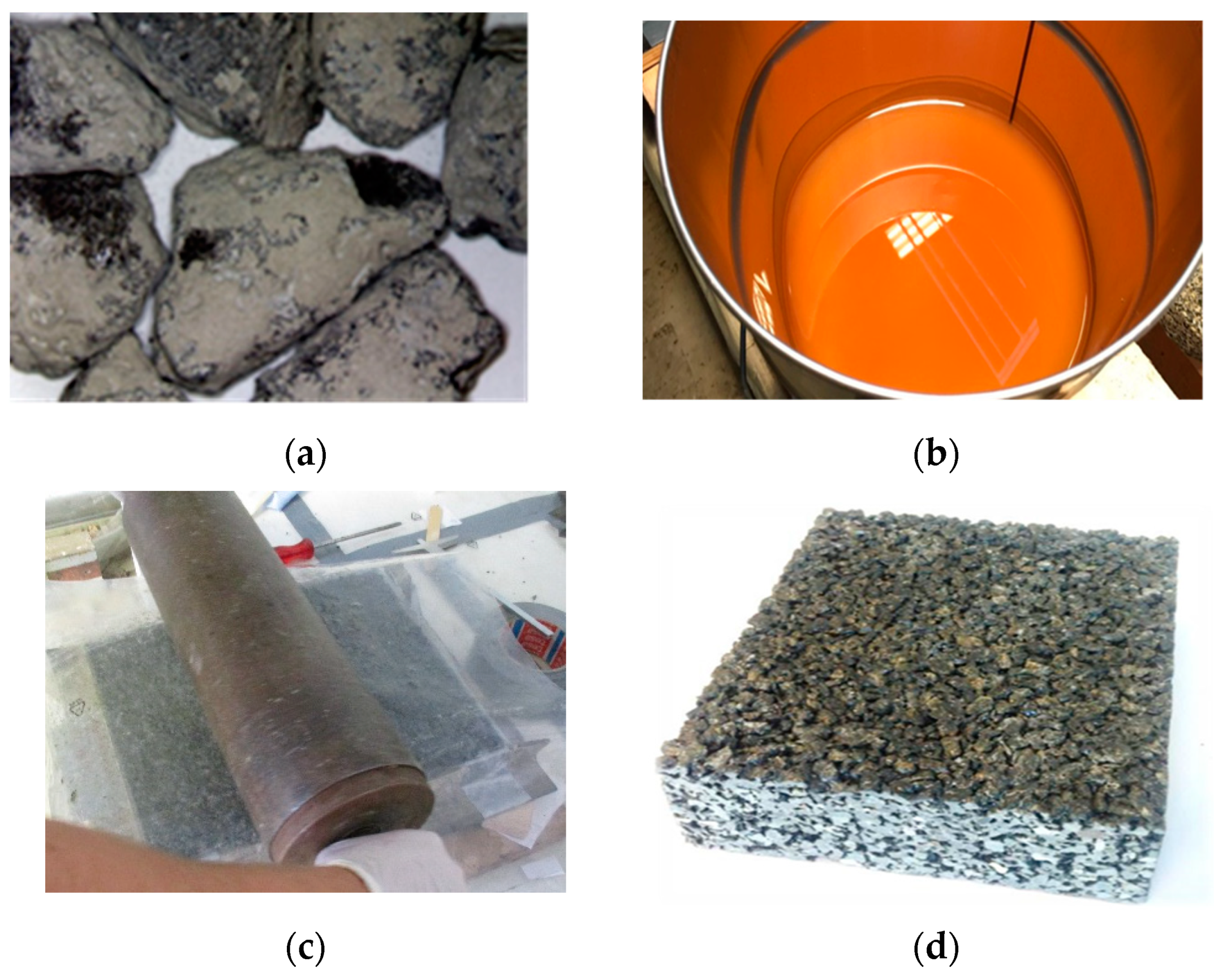


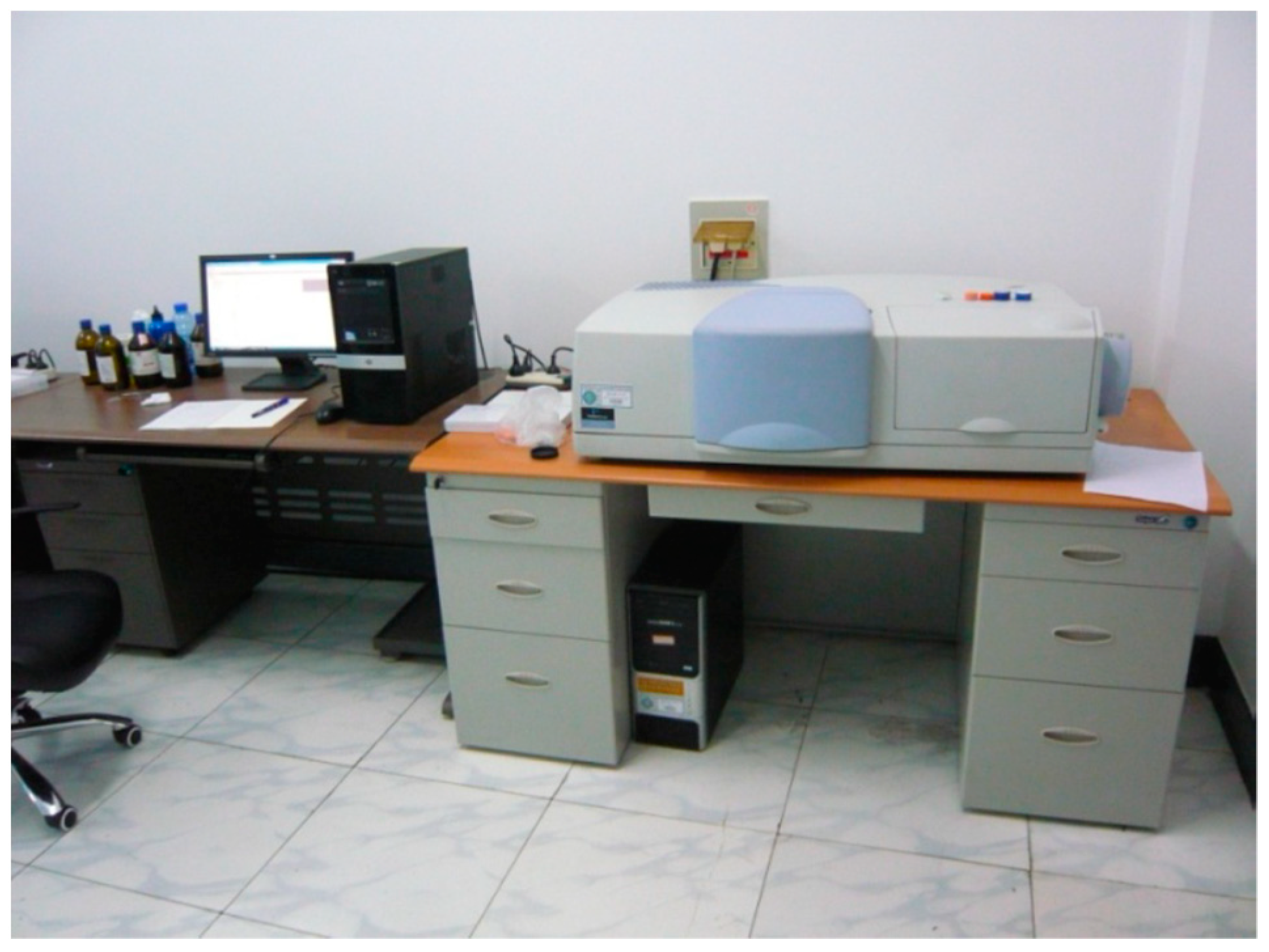
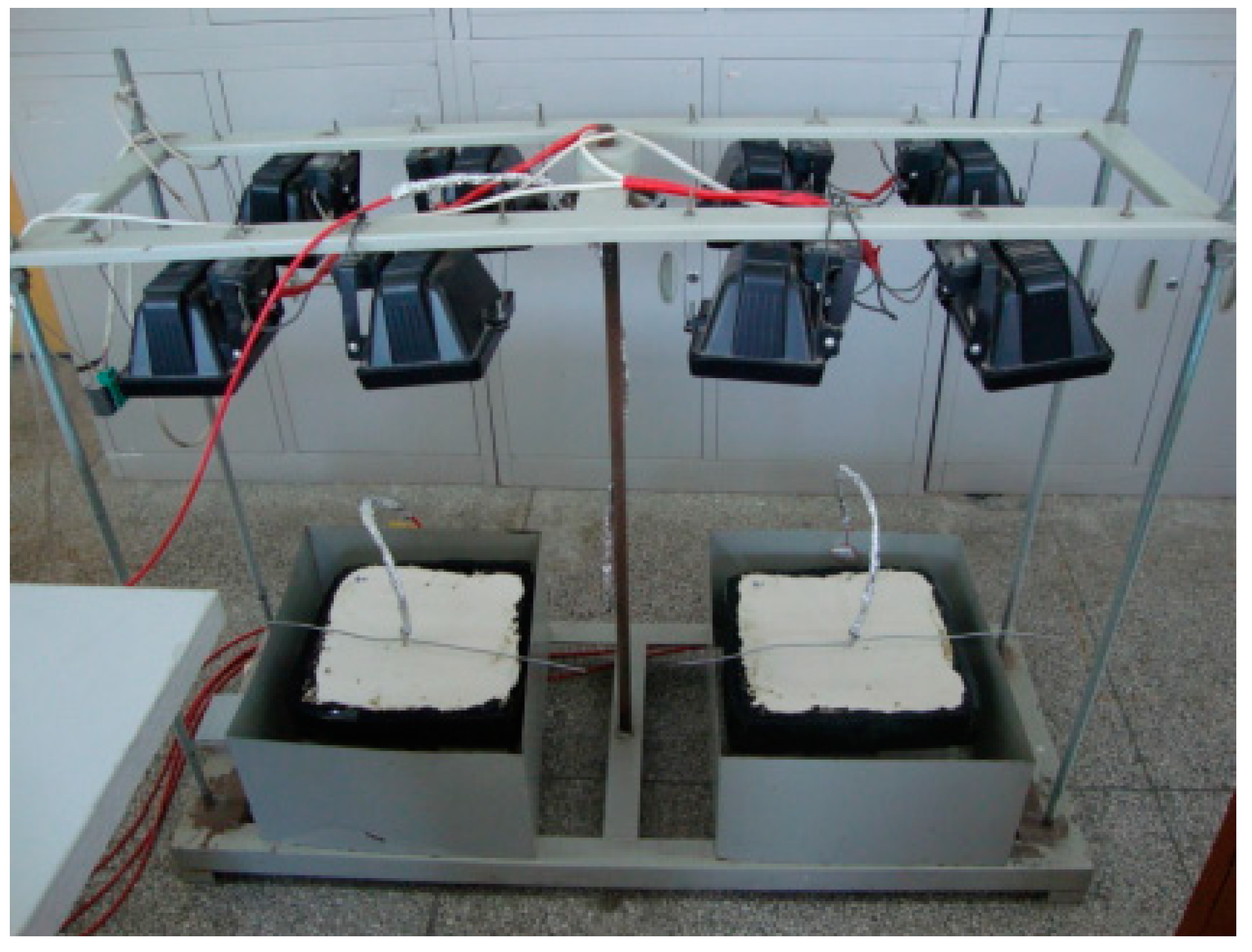
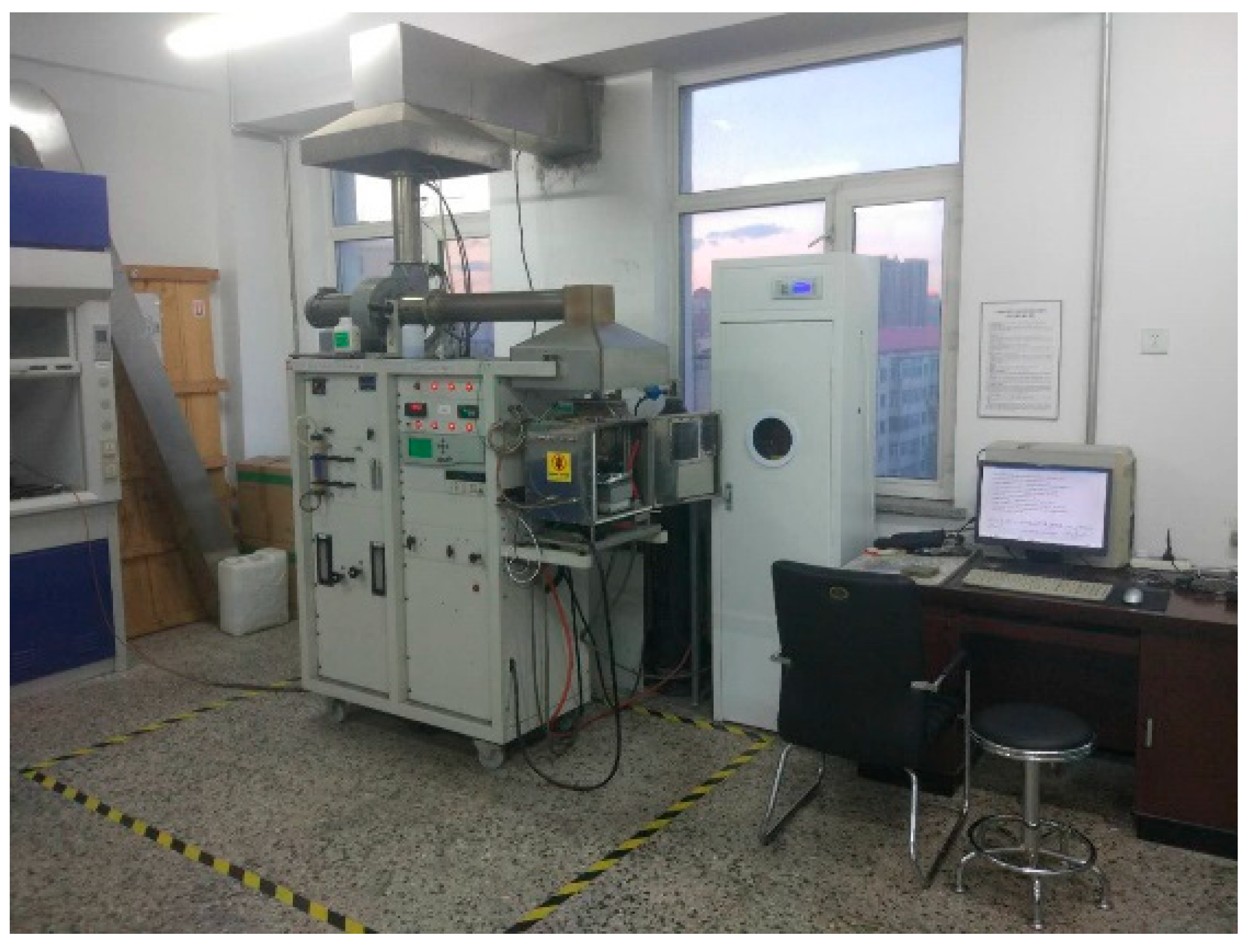
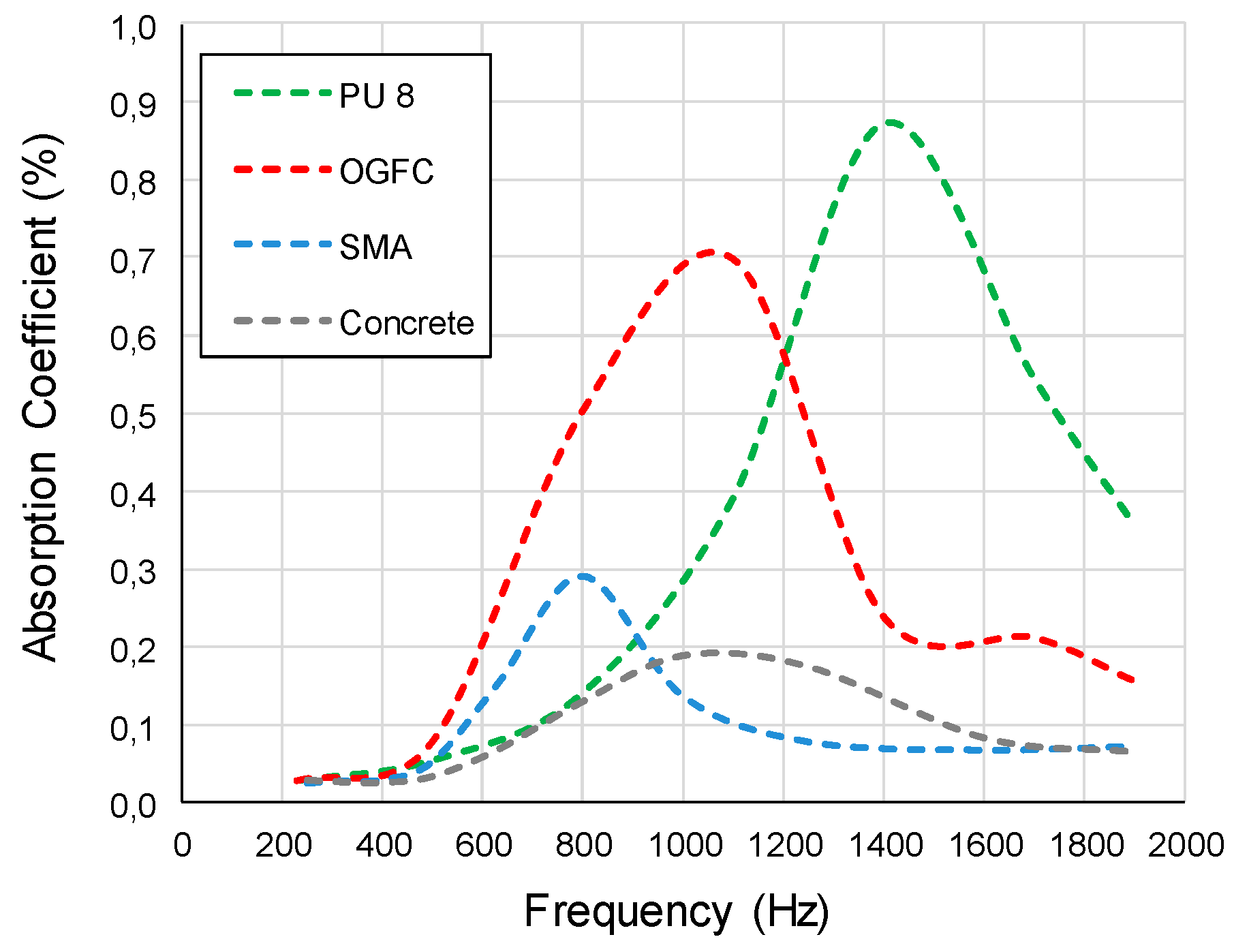
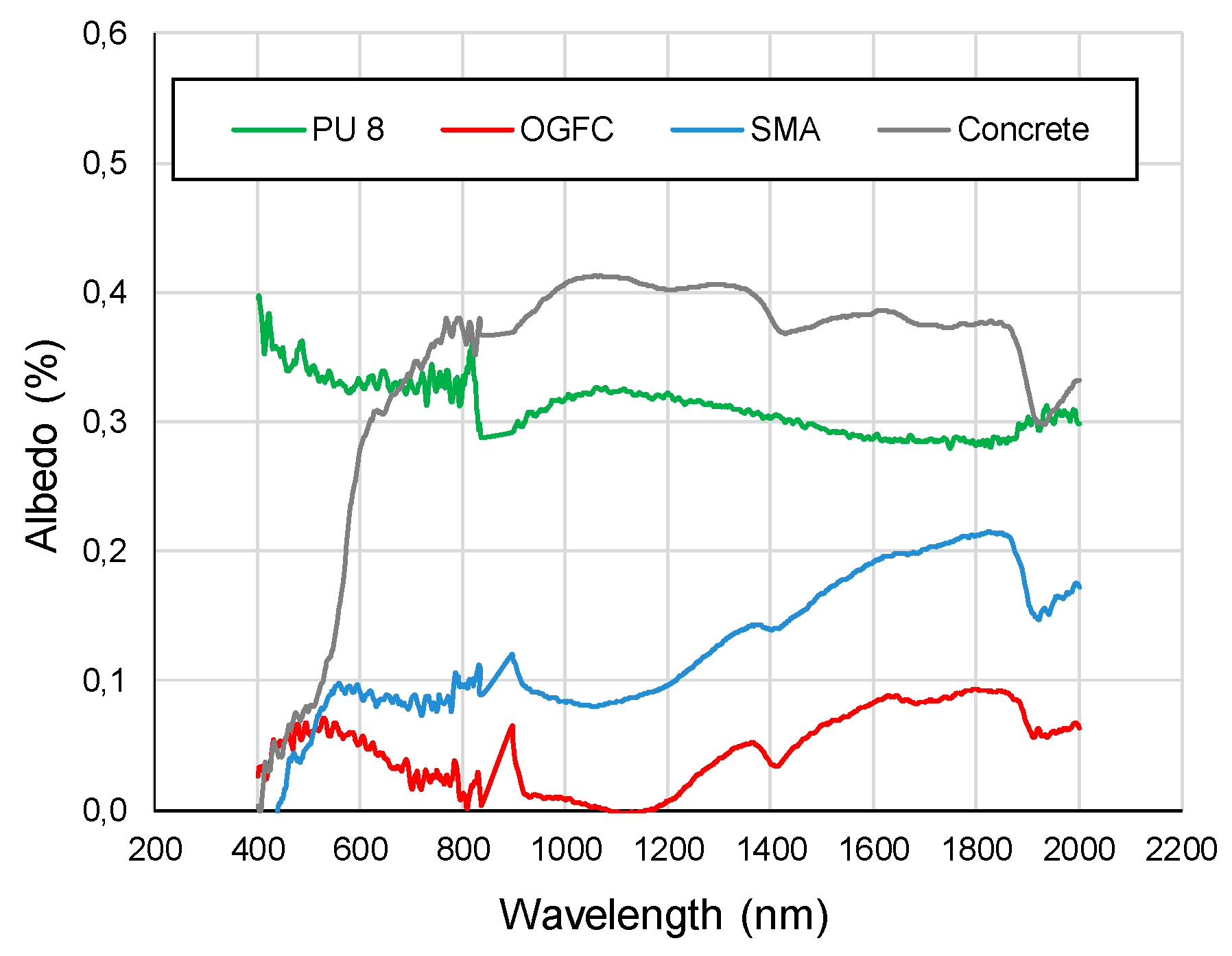

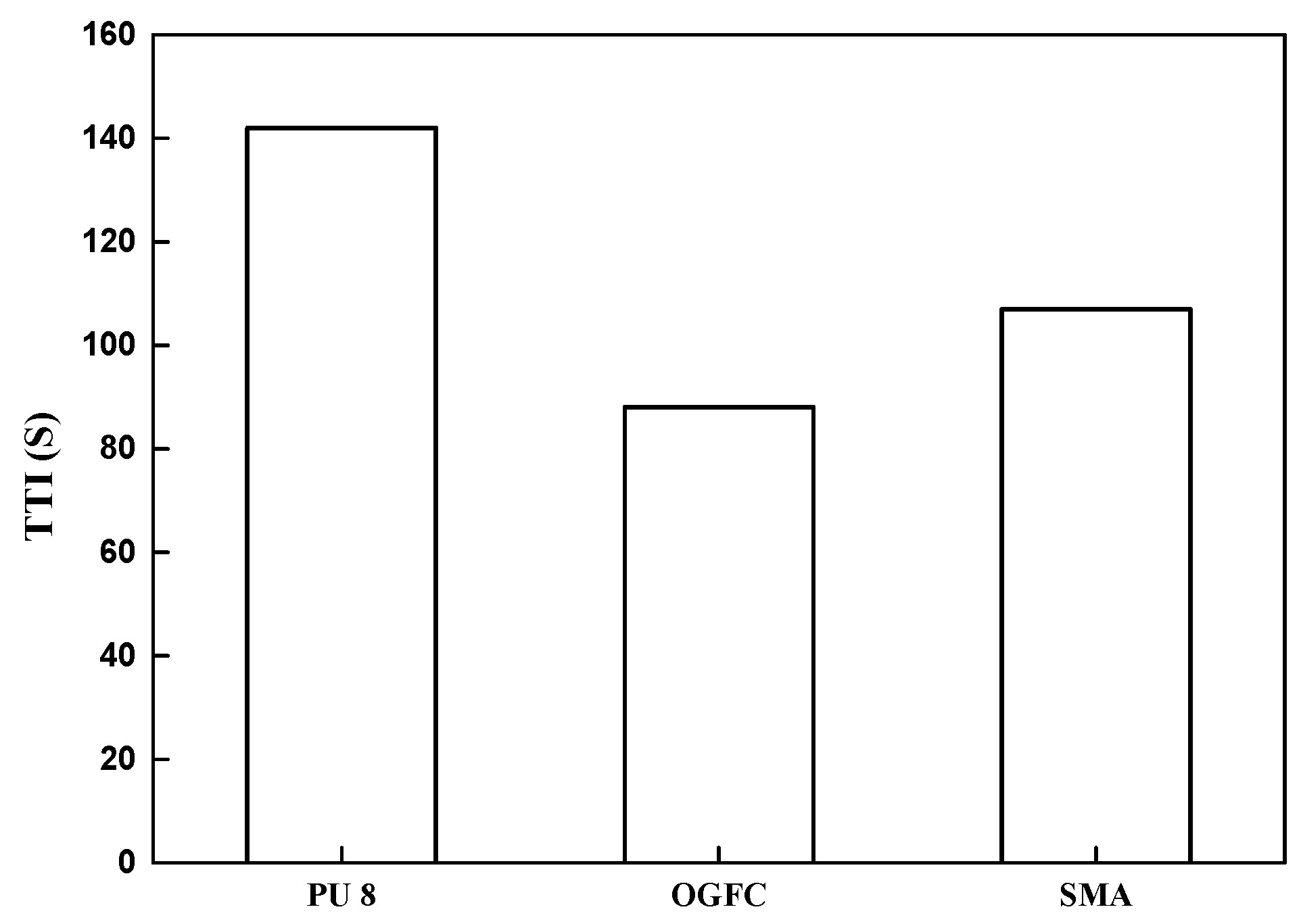

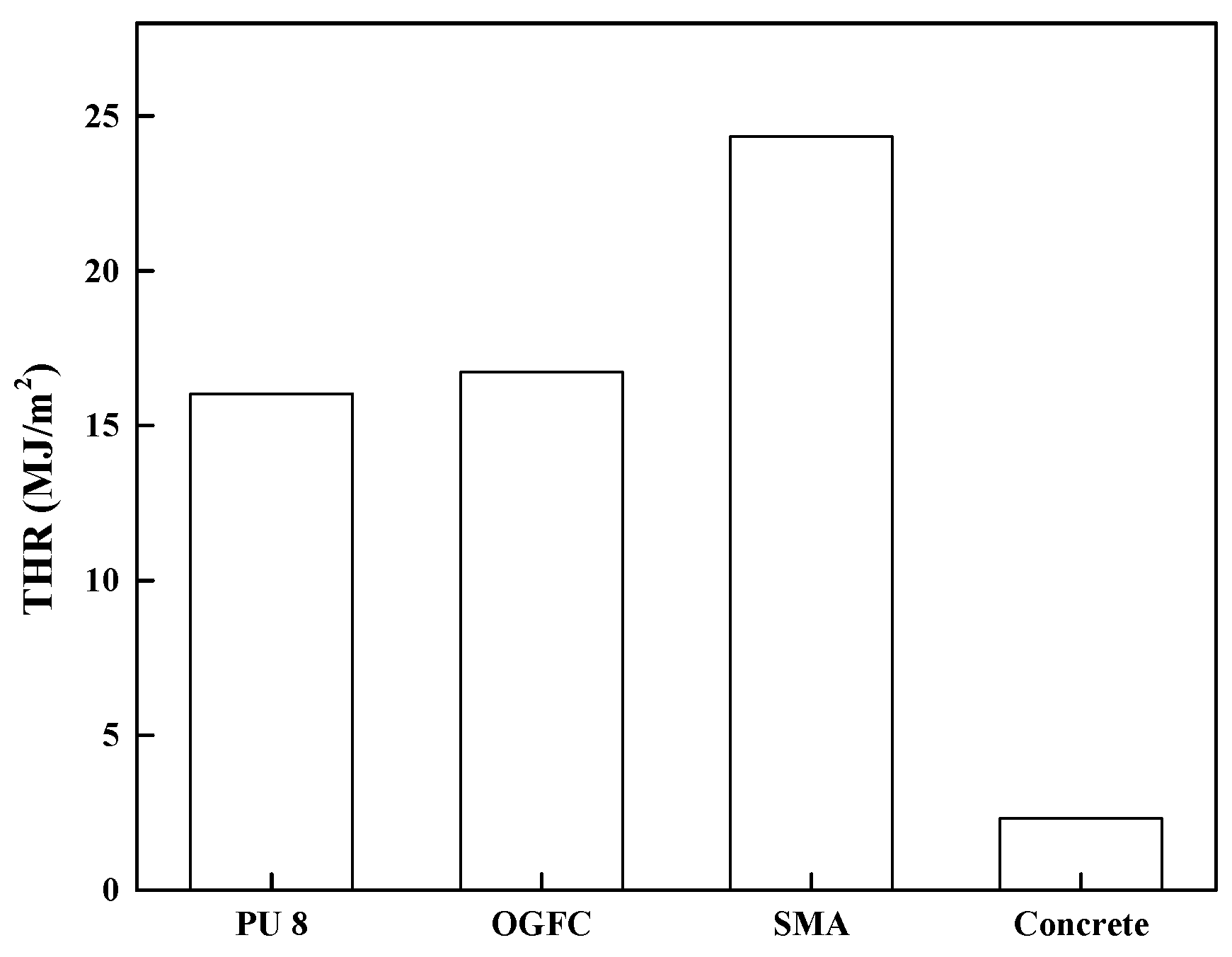
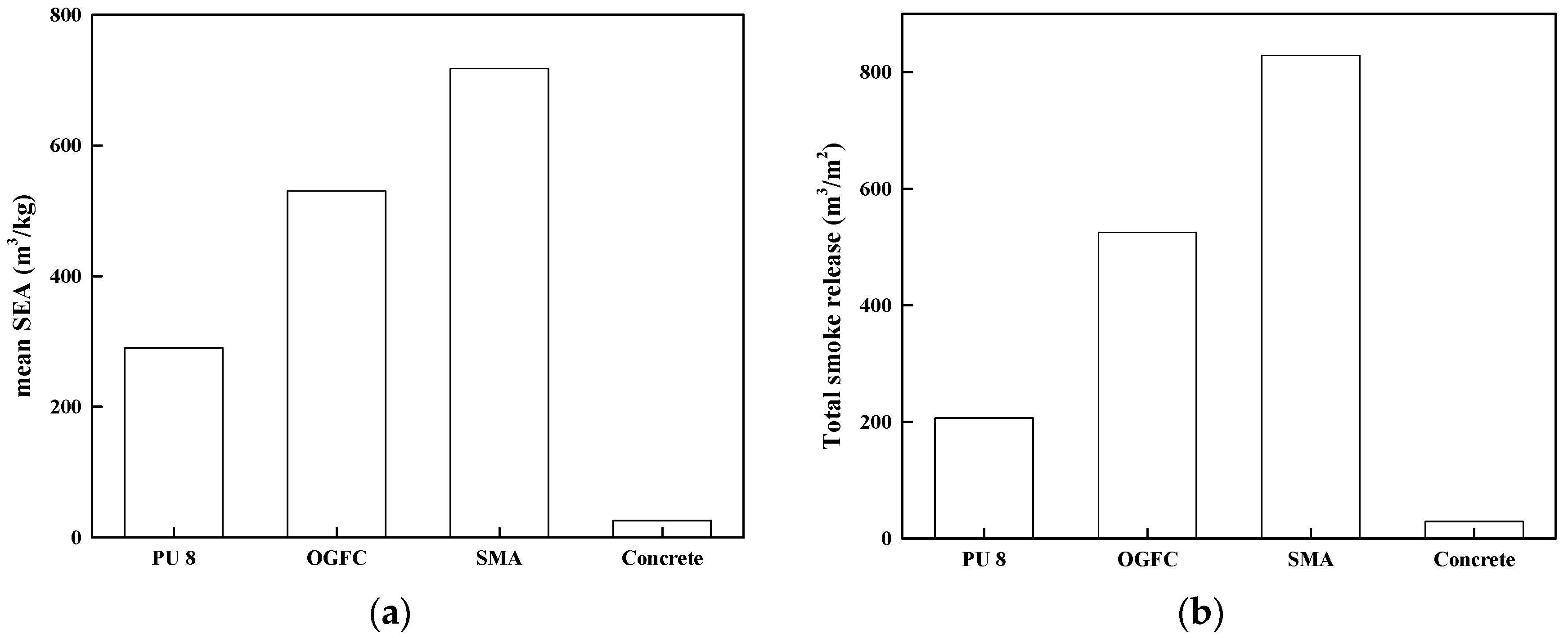
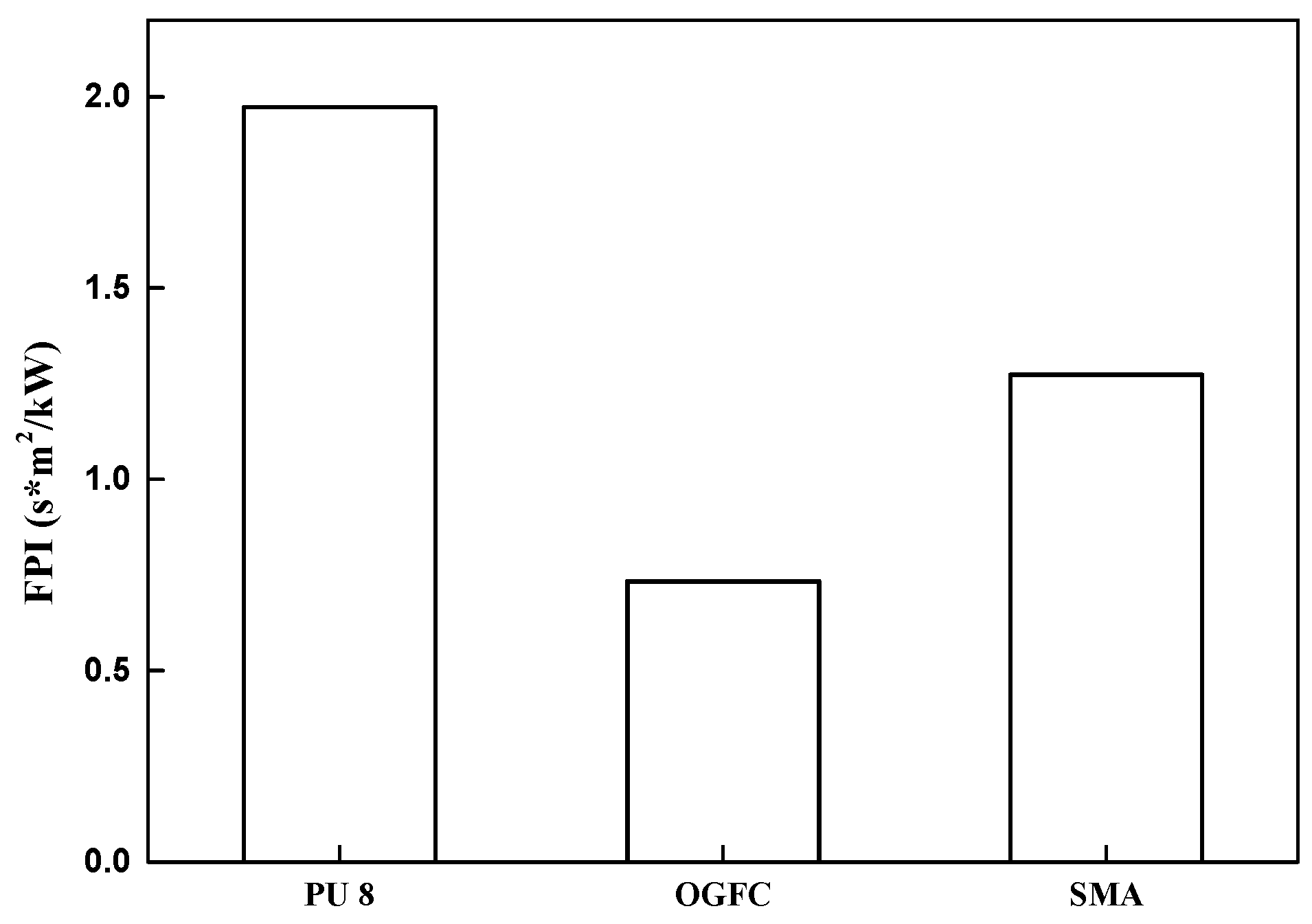
| PU Materials | Grain Size (mm) | Mass Percentage (%) | Apparent Density (g/cm3) |
|---|---|---|---|
| Limestone | 0−0.063 | 5.0 | 2.820 |
| Diabase | 0.063−2 | 15.0 | 2.850 |
| 2−5.6 | 52.0 | 2.850 | |
| 5.6−8 | 100.0 | 2.850 | |
| Polyurethane | 2-component polyurethane, 6.5 M.−% | 1.09 | |
| PU Mixtures | Air void content 28.9 Vol.−% | 1.93 | |
| OGFC Materials | Grain Size (mm) | Mass Percentage (%) | Apparent Density (g/cm3) |
|---|---|---|---|
| Limestone | 0−0.075 | 4.0 | 2.820 |
| Basalt | 0.075−2.36 | 10.2 | 2.820 |
| 2.36−9.5 | 62.3 | 2.820 | |
| 9.5−16 | 23.5 | 2.820 | |
| Bitumen | Polymer modified bitumen 40/100–65 A, 4.5 M.−% | 1.472 | |
| OGFC Mixture | Air void content 21.2 Vol.−% | 2.090 | |
| SMA Materials | Grain Size (mm) | Mass Percentage (%) | Apparent Density (g/cm3) |
|---|---|---|---|
| Limestone | 0−0.075 | 10.0 | 2.820 |
| Basalt | 0.075−2.36 | 9.5 | 2.820 |
| 2.36−9.5 | 35.5 | 2.820 | |
| 9.5−16 | 40.0 | 2.820 | |
| 16−19 | 5.0 | ||
| Bitumen | Polymer modified bitumen 40/100–65 A, 5.4 M.−% | 1.472 | |
| SMA Mixture | Air void content 3.1 Vol.−% | 2.471 | |
| Cement | Pulverized Fuel Ash | 20 mm | 10 mm | Fines | Water | Aggregate Cement Ratio | Water Cement Ratio |
|---|---|---|---|---|---|---|---|
| 330 | 110 | 725 | 345 | 620 | 185 | 3.84 | 0.42 |
© 2019 by the authors. Licensee MDPI, Basel, Switzerland. This article is an open access article distributed under the terms and conditions of the Creative Commons Attribution (CC BY) license (http://creativecommons.org/licenses/by/4.0/).
Share and Cite
Leng, C.; Lu, G.; Gao, J.; Liu, P.; Xie, X.; Wang, D. Sustainable Green Pavement Using Bio-Based Polyurethane Binder in Tunnel. Materials 2019, 12, 1990. https://doi.org/10.3390/ma12121990
Leng C, Lu G, Gao J, Liu P, Xie X, Wang D. Sustainable Green Pavement Using Bio-Based Polyurethane Binder in Tunnel. Materials. 2019; 12(12):1990. https://doi.org/10.3390/ma12121990
Chicago/Turabian StyleLeng, Chao, Guoyang Lu, Junling Gao, Pengfei Liu, Xiaoguang Xie, and Dawei Wang. 2019. "Sustainable Green Pavement Using Bio-Based Polyurethane Binder in Tunnel" Materials 12, no. 12: 1990. https://doi.org/10.3390/ma12121990





